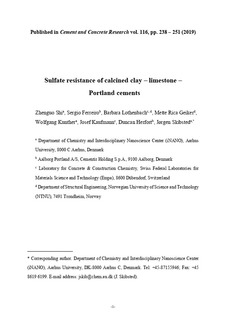| dc.contributor.author | Shi, Zhenguo | |
| dc.contributor.author | Ferreiro, Sergio | |
| dc.contributor.author | Lothenbach, Barbara | |
| dc.contributor.author | Geiker, Mette Rica | |
| dc.contributor.author | Kunther, Wolfgang | |
| dc.contributor.author | Kaufmann, Josef | |
| dc.contributor.author | Herforth, Duncan | |
| dc.contributor.author | Skibsted, Jørgen | |
| dc.date.accessioned | 2019-11-18T12:24:54Z | |
| dc.date.available | 2019-11-18T12:24:54Z | |
| dc.date.created | 2018-12-31T20:46:10Z | |
| dc.date.issued | 2019 | |
| dc.identifier.citation | Cement and Concrete Research. 2019, 116 238-251. | nb_NO |
| dc.identifier.issn | 0008-8846 | |
| dc.identifier.uri | http://hdl.handle.net/11250/2629032 | |
| dc.description.abstract | Calcined clays emerge as a promising source of supplementary cementitious material, which can provide a significant lowering of the Portland clinker content in blended cements. This study focusses on sulfate resistance of calcined clay (CC) – limestone (L) – Portland cements for mortars exposed to a 0.11 M Na2SO4 solution at 5 and 20 °C after a hydration period of 91 days. The pozzolanicity, compressive strength, pore structure, and sulfate resistance of mortars containing laboratory-made metakaolin or calcined montmorillonite and limestone have been investigated in cements with 35 wt% replacement of a white Portland or an ordinary Portland clinker. The results show that all mortars with CC/(CC + L) ≥ 0.5 exhibit excellent sulfate resistance. The consumption of portlandite by the pozzolanic reactions of the calcined clays and the dilution of the Portland clinker lead to a lower amount of calcium available for the secondary formation of gypsum and ettringite, which is identified as the main reason for the excellent sulfate resistance of the ternary blends. The results suggest that calcined clay – limestone – Portland cements are included in standards as a new type of sulfate-resisting Portland pozzolana cement and Portland composite cement. | nb_NO |
| dc.language.iso | eng | nb_NO |
| dc.publisher | Elsevier | nb_NO |
| dc.rights | Attribution-NonCommercial-NoDerivatives 4.0 Internasjonal | * |
| dc.rights.uri | http://creativecommons.org/licenses/by-nc-nd/4.0/deed.no | * |
| dc.title | Sulfate resistance of calcined clay – Limestone – Portland cements | nb_NO |
| dc.type | Journal article | nb_NO |
| dc.type | Peer reviewed | nb_NO |
| dc.description.version | acceptedVersion | nb_NO |
| dc.source.pagenumber | 238-251 | nb_NO |
| dc.source.volume | 116 | nb_NO |
| dc.source.journal | Cement and Concrete Research | nb_NO |
| dc.identifier.doi | 10.1016/j.cemconres.2018.11.003 | |
| dc.identifier.cristin | 1647981 | |
| dc.description.localcode | © 2018. This is the authors’ accepted and refereed manuscript to the article. Locked until 10.12.2020 due to copyright restrictions. This manuscript version is made available under the CC-BY-NC-ND 4.0 license http://creativecommons.org/licenses/by-nc-nd/4.0/ | nb_NO |
| cristin.unitcode | 194,64,45,0 | |
| cristin.unitname | Institutt for konstruksjonsteknikk | |
| cristin.ispublished | true | |
| cristin.fulltext | postprint | |
| cristin.qualitycode | 2 | |

